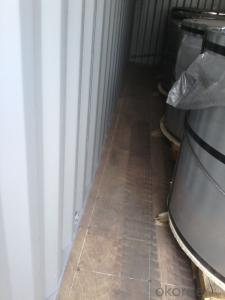PRIME GOOD QUALITY Tinplate ETP For Chemical Can
- Loading Port:
- China Main Port
- Payment Terms:
- TT OR LC
- Min Order Qty:
- -
- Supply Capability:
- -
OKorder Service Pledge
OKorder Financial Service
You Might Also Like
We have been producing tinplate material professionally and providing related service for decades years. Now we have been exporting our material to the world. Please kindly contact us to meet your needs for ETP materail.
Below is the specification we currently do:
1. Standard: GB/T 2520-2000, JIS G3303-2002 and DIN EN 10203-1991
2. Raw material: MR, SPCC
3.Thickness: 0.18 to 0.50mm
4. Width: 260 to 980mm
5. Coil diameter: ID 420mm or 508mm
6. Temper grade: T2, T3 and T4
7. Tin coating: ordinary 2.8 or 2.8g and 5.6g or 5.6g, can produce according to customer's requests
8. Applications: paint, chemical and other usage can make battery, electric cable and other industries
9. Package: anti-rust paper, corner protected. Sheets or coils according customer's request.
Standard for Temper:
code | Chinese Stardard | Japaness Standard | American Standard | European Standard | International Standard |
| GB/T 2520-2000 | JIS G3303-2002 | ASTM A623M-2002 | DIN EN 10203-1991 | ISO 11949-1995 |
T-2 | TH52+SE | T-2 | T-2(53) | T52 | TH52+SE |
T-2.5 | TH55+SE | T-2.5 |
|
| TH55+SE |
T-3 | TH57+SE | T-3 | T-3(T57) | T57 | TH57+SE |
T-3.5 |
|
|
|
|
|
T-4 | TH61+SE | T-4 | T-4(T61) | T61 | TH61+SE |
Surface of tinplate:
Marks | Surface state | Characteristics |
B | Bright rough | Glazed surface obtained after melting treatment of electrotinned smooth raw material strip featuring certain oriented rubstone figure. |
R | Stone rough | Glazed surface obtained after melting treatment of electrotinned raw material strip featuring certain oriented rubstone figure. |
S | Silver rough | Glazed surface obtained after melting treatment of electrotinned raw material strip with rough matt surface. |
- Q: What are the challenges in manufacturing tinplate?
- Some of the challenges in manufacturing tinplate include ensuring the uniformity of tin coating on the steel base, preventing corrosion during storage and transportation, maintaining the dimensional accuracy of the tinplate sheets, and addressing environmental concerns related to the disposal of tin and tin-containing wastewater. Additionally, meeting the specific quality requirements of different industries and managing the cost of production can also be challenging in tinplate manufacturing.
- Q: What are some common tinplate products?
- Some common tinplate products include food cans, beverage cans, aerosol cans, metal closures, and tinplate packaging for various consumer goods.
- Q: How is tinplate affected by exposure to oxygen?
- Tinplate is prone to oxidation when exposed to oxygen, leading to the formation of a tin oxide layer on its surface. This oxide layer can impact the appearance, adhesion, and corrosion resistance of the tinplate.
- Q: What are the typical lead times for tinplate production?
- The typical lead times for tinplate production can vary depending on factors such as the quantity required, complexity of the design, and the manufacturer's production capacity. However, on average, lead times for tinplate production usually range from several weeks to a few months.
- Q: Does tinplate require any specific handling or storage conditions?
- Yes, tinplate does require specific handling and storage conditions. It should be protected from moisture and kept in a dry environment to prevent rusting. Additionally, it is recommended to store tinplate in a cool and well-ventilated area to maintain its quality and prevent any potential damage.
- Q: How does tinplate perform in terms of odor and taste retention?
- Tinplate is highly effective in retaining the odor and taste of the contents it holds. The tin coating on the steel provides an excellent barrier that prevents any transfer of flavors or smells, ensuring the preservation of the original quality and taste of the product.
- Q: What are the advantages of using tinplate for promotional items?
- Tinplate offers several advantages for promotional items, including its durability, versatility, and visual appeal. It is a sturdy material that can withstand rough handling, making it ideal for long-lasting promotional products. Additionally, tinplate can be easily molded into various shapes and sizes, allowing for unique and creative designs. Its glossy finish provides an attractive and eye-catching appearance, enhancing the overall appeal of promotional items.
- Q: What are the typical transportation requirements for tinplate?
- The typical transportation requirements for tinplate involve careful handling to prevent damage or denting, as well as protection from moisture to avoid rusting. Tinplate is often transported in specialized packaging or containers to ensure its safety during transit. Additionally, the transportation process should consider the weight and volume of the tinplate to determine the appropriate mode of transportation, whether it be by truck, rail, or sea.
- Q: How does tinplate impact the ease of opening and closing packaging?
- Tinplate can greatly impact the ease of opening and closing packaging due to its durability and malleability. It provides a sturdy and rigid structure to packaging, ensuring that it maintains its shape and integrity, making it easier to open and close repeatedly without any damage or distortion. Additionally, tinplate's smooth surface allows for effortless sliding and gliding when opening or closing packaging, further enhancing the overall user experience.
- Q: Can tinplate be easily opened and resealed?
- No, tinplate cannot be easily opened and resealed as it typically requires specialized tools or equipment to open and seal it properly.
Send your message to us
PRIME GOOD QUALITY Tinplate ETP For Chemical Can
- Loading Port:
- China Main Port
- Payment Terms:
- TT OR LC
- Min Order Qty:
- -
- Supply Capability:
- -
OKorder Service Pledge
OKorder Financial Service
Similar products
Hot products
Hot Searches
Related keywords




























